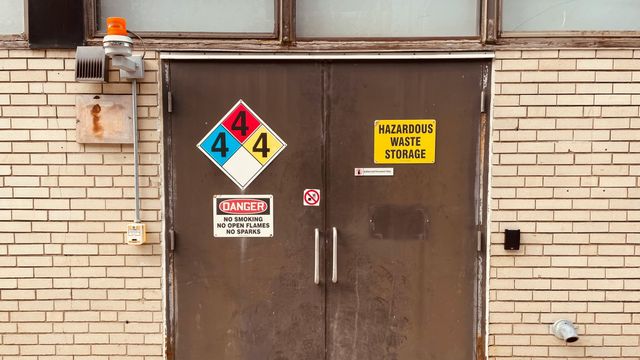Composite Metal Foam Could Be Used for Safer Hazmat Transportation – Technology Networks

Report on Composite Metal Foam for Safer Hazardous Material Transportation and its Contribution to Sustainable Development Goals
Executive Summary
A recent study highlights the significant potential of Composite Metal Foam (CMF) to enhance the safety of hazardous material transportation. The material’s superior ability to absorb impact energy at a lower weight than conventional steel presents a direct pathway to advancing several United Nations Sustainable Development Goals (SDGs). This report outlines the study’s findings and analyzes the role of CMF in promoting resilient infrastructure (SDG 9), creating safer communities (SDG 11), protecting public health (SDG 3), and encouraging responsible production patterns (SDG 12).
Technological Innovation: Composite Metal Foam (CMF)
Material Properties and Composition
Composite Metal Foam is an advanced material with properties highly conducive to safety and sustainability applications. Its key attributes include:
- Lightweight Structure: CMF consists of hollow metallic spheres embedded within a solid metallic matrix, resulting in a significantly lower density than solid metals.
- High Energy Absorption: The material demonstrates a remarkable capacity to absorb compressive forces and impact energy, making it exceptionally strong and durable.
- Superior Thermal Insulation: CMF provides better insulation against high heat compared to conventional steel and maintains its strength when exposed to high temperatures.
Puncture Resistance Test Findings
To validate its performance, CMF was subjected to rigorous testing simulating a high-impact event on a railroad tank car.
- Test Parameters: A 300,000-pound ram car, fitted with a six-inch square steel indenter, was accelerated to 5.2 miles per hour, generating 368 kilojoules of force.
- Baseline Result: In a control test, the indenter created a large puncture in a standard steel plate used for tank cars.
- CMF Result: When a 30.48 mm thick layer of CMF was placed on the indenter, it absorbed the vast majority of the impact force. The ram car bounced off the steel plate, leaving only a minor dent and preventing any puncture.
A computational model has also been developed to optimize the thickness of CMF required for specific applications, ensuring maximum safety and material efficiency.
Alignment with Sustainable Development Goals (SDGs)
The development and application of CMF technology directly contribute to achieving key targets within the UN’s 2030 Agenda for Sustainable Development.
SDG 9: Industry, Innovation, and Infrastructure
CMF represents a significant innovation that builds resilient, reliable, and sustainable infrastructure.
- Enhanced Infrastructure Resilience: By creating puncture-proof tank cars, CMF strengthens critical transportation infrastructure against accidents and potential disasters.
- Promotion of Sustainable Industrialization: The technology fosters innovation in materials science and manufacturing, leading to safer industrial practices.
- Upgrading Infrastructure: It provides a clear technological path for upgrading the global fleet of vehicles used for transporting hazardous goods.
SDG 11: Sustainable Cities and Communities
The implementation of CMF in hazmat transport makes human settlements safer and more resilient.
- Reduced Risk of Technological Disasters: Safer tank cars significantly lower the risk of chemical spills, explosions, or leaks in and around populated areas.
- Protection of Life and Environment: Preventing accidents protects urban and rural communities from exposure to toxic substances and minimizes environmental contamination.
SDG 3: Good Health and Well-being
By preventing the release of hazardous materials, CMF technology directly supports public health and safety.
- Prevention of Hazardous Chemical Exposure: The technology helps achieve Target 3.9, which aims to substantially reduce the number of deaths and illnesses from hazardous chemicals and pollution.
- Accident Prevention: Mitigating the risk of transport accidents prevents injuries and fatalities among workers and the general public.
SDG 12: Responsible Consumption and Production
CMF contributes to the environmentally sound management of chemicals and promotes resource efficiency.
- Safe Management of Chemicals and Waste: The technology directly supports Target 12.4 by ensuring the safe containment and transport of hazardous materials throughout their life cycle.
- Resource Efficiency: As a lightweight material, CMF can reduce the overall weight of transport vehicles, potentially leading to lower fuel consumption and reduced greenhouse gas emissions during transit.
Conclusion
The successful testing of Composite Metal Foam marks a critical advancement in materials science with profound implications for public safety and sustainable development. Its ability to prevent catastrophic punctures in tank cars used for hazardous materials aligns directly with the objectives of SDGs 3, 9, 11, and 12. The widespread adoption of this technology offers a tangible solution for building more resilient infrastructure, ensuring safer communities, and promoting responsible industrial practices globally.
Analysis of Sustainable Development Goals in the Article
1. Which SDGs are addressed or connected to the issues highlighted in the article?
-
SDG 3: Good Health and Well-being
- The article focuses on developing safer transportation for hazardous materials like acids, chemicals, and petroleum. Preventing accidents and spills of these materials directly contributes to protecting human health from exposure to toxic substances and avoiding injuries or fatalities from potential explosions or contamination.
-
SDG 9: Industry, Innovation, and Infrastructure
- The core of the article is about technological innovation—the development and testing of Composite Metal Foam (CMF). This innovation is aimed at upgrading critical infrastructure, specifically railroad tank cars, to make them more resilient and safer, thereby improving the industrial sector responsible for transporting hazardous goods.
-
SDG 11: Sustainable Cities and Communities
- Rail transport networks for hazardous materials often pass through or near populated areas. Enhancing the safety of tank cars makes communities more resilient to potential man-made disasters, such as chemical spills or explosions, which could have devastating effects on urban and rural populations.
-
SDG 12: Responsible Consumption and Production
- This goal includes the environmentally sound management of chemicals throughout their life cycle. Safe and secure transportation is a critical component of this life cycle. By preventing the accidental release of hazardous materials into the environment, the technology discussed in the article supports the goal of minimizing adverse impacts on human health and ecosystems.
2. What specific targets under those SDGs can be identified based on the article’s content?
-
Under SDG 3: Good Health and Well-being
- Target 3.9: By 2030, substantially reduce the number of deaths and illnesses from hazardous chemicals and air, water and soil pollution and contamination. The development of puncture-resistant CMF for tank cars is a direct measure to prevent the release of hazardous chemicals, thus reducing the risk of deaths and illnesses from contamination events.
-
Under SDG 9: Industry, Innovation, and Infrastructure
- Target 9.1: Develop quality, reliable, sustainable and resilient infrastructure. The article describes research aimed at creating a “safer generation of tanker cars,” which directly contributes to making transportation infrastructure more resilient against accidents and impacts.
- Target 9.5: Enhance scientific research, upgrade the technological capabilities of industrial sectors. The entire article is a case study of this target, detailing the research, development, and testing of a new material (CMF) and a “computational model” to upgrade the safety standards of the hazardous materials transport industry. The work is explicitly supported by a government grant for this purpose.
-
Under SDG 11: Sustainable Cities and Communities
- Target 11.5: By 2030, significantly reduce the number of deaths and the number of people affected and substantially decrease the direct economic losses… caused by disasters. A major accident involving a hazardous material tanker is a form of man-made disaster. The CMF technology is designed to prevent such disasters, thereby reducing potential deaths, injuries, and economic damage to communities along transport routes.
-
Under SDG 12: Responsible Consumption and Production
- Target 12.4: By 2020, achieve the environmentally sound management of chemicals and all wastes throughout their life cycle… and significantly reduce their release to air, water and soil. The article’s focus on preventing punctures in tank cars is a direct effort to stop the unintended release of hazardous chemicals into the environment during transportation, a key phase in their life cycle.
3. Are there any indicators mentioned or implied in the article that can be used to measure progress towards the identified targets?
-
Implied Indicators for Safety and Resilience (Targets 3.9, 9.1, 11.5)
- Reduction in transport accidents involving hazardous materials: The primary goal is to prevent breaches. A key metric would be the number of punctures or spills from tank cars in accidents.
- Material performance under stress: The article explicitly mentions the force applied during testing (“368 kilojoules of force”) and the outcome (“tore a gaping hole in the steel plate” vs. “leaving only a small dent”). These performance metrics can serve as indicators of material resilience.
- Reduction in fatalities and injuries: Progress towards Target 3.9 and 11.5 could be measured by a decrease in the number of deaths and injuries attributed to hazardous material transportation incidents.
-
Implied Indicators for Innovation (Target 9.5)
- Investment in research and development: The article mentions that the “work was done with support from the Department of Transportation’s Pipeline and Hazardous Materials Safety Administration under project number PH95720-0075.” This grant represents public R&D spending, an indicator for this target.
- Development of new technologies and models: The creation of CMF itself and the associated “computational model that can be used to determine what thickness of CMF is needed” are direct outputs of innovation and can be tracked as indicators of technological advancement.
-
Implied Indicators for Environmental Protection (Target 12.4)
- Volume of hazardous materials spilled: A direct measure of progress would be the reduction in the total volume of chemicals, petroleum, and other hazardous substances released into the environment due to transportation accidents. The article’s technology aims to reduce this to zero in puncture scenarios.
4. Summary Table of SDGs, Targets, and Indicators
| SDGs | Targets | Indicators (Mentioned or Implied in the Article) |
|---|---|---|
| SDG 3: Good Health and Well-being | 3.9: Substantially reduce deaths and illnesses from hazardous chemicals and pollution. |
|
| SDG 9: Industry, Innovation, and Infrastructure |
9.1: Develop quality, reliable, sustainable and resilient infrastructure.
9.5: Enhance scientific research and upgrade technological capabilities. |
|
| SDG 11: Sustainable Cities and Communities | 11.5: Significantly reduce deaths, affected people, and economic losses from disasters. |
|
| SDG 12: Responsible Consumption and Production | 12.4: Achieve environmentally sound management of chemicals and reduce their release. |
|
Source: technologynetworks.com
What is Your Reaction?
 Like
0
Like
0
 Dislike
0
Dislike
0
 Love
0
Love
0
 Funny
0
Funny
0
 Angry
0
Angry
0
 Sad
0
Sad
0
 Wow
0
Wow
0
















































/environment-climate-change-and-health-(ech)/water-sanitation-hygiene-and-health-(wsh)/landfill-tuvalu-36092.tmb-1200v.jpg?sfvrsn=5c21fe40_1#)

.jpg.webp?itok=0ZsAnae9#)

























